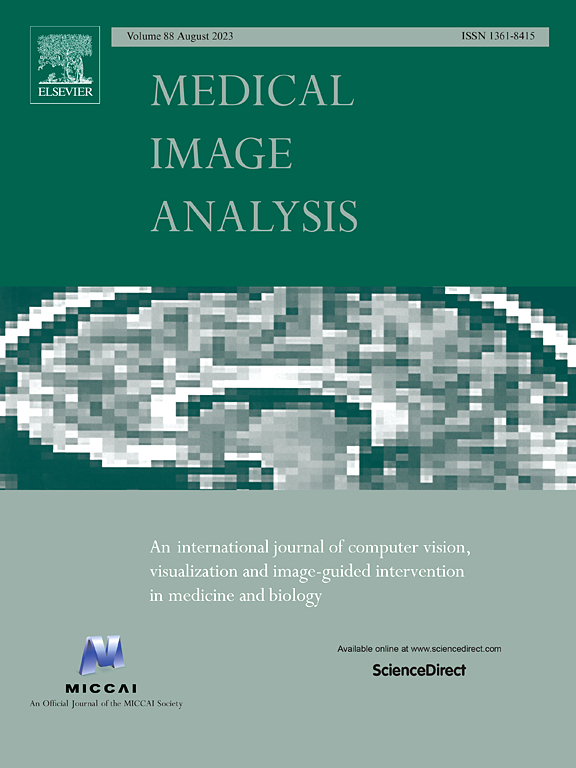用于脑网络分析和潜在生物标记物发现的知识驱动多图卷积网络
IF 10.7
1区 医学
Q1 COMPUTER SCIENCE, ARTIFICIAL INTELLIGENCE
引用次数: 0
摘要
在脑网络分析中,个体层面的数据可以提供个体的生物学特征,而群体层面的数据则可以提供群体的人口学信息。然而,现有的方法大多是分别利用个体或群体层面的特征,难免忽略了脑疾病的多层次特征。针对这一问题,我们提出了一种端到端的多图神经网络模型,称为 KMGCN。该模型可同时利用个体和群体层面的特征进行脑网络分析。在个体层面,我们采用知识驱动和数据驱动两种方法构建多图。知识驱动指的是根据已有知识构建知识图谱,而数据驱动指的是从数据本身学习数据图谱。在群体层面,我们利用成像和表型数据构建多图。此外,我们还设计了一种专为大脑网络量身定制的池化方法,能够筛选出影响大脑疾病的大脑区域。我们在两个大型数据集(ADNI 和 ABIDE)上评估了我们模型的性能,实验结果表明它达到了最先进的性能,ADNI 和 ABIDE 的分类准确率分别为 86.87% 和 86.40%,与最先进的模型相比,所有评估指标都提高了约 10%。此外,我们的模型识别出的生物标记物与最近的神经科学研究非常吻合,这表明我们的模型在大脑网络分析和潜在生物标记物发现方面非常有效。代码见 https://github.com/GN-gjh/KMGCN。本文章由计算机程序翻译,如有差异,请以英文原文为准。
Knowledge-driven multi-graph convolutional network for brain network analysis and potential biomarker discovery
In brain network analysis, individual-level data can provide biological features of individuals, while population-level data can provide demographic information of populations. However, existing methods mostly utilize either individual- or population-level features separately, inevitably neglecting the multi-level characteristics of brain disorders. To address this issue, we propose an end-to-end multi-graph neural network model called KMGCN. This model simultaneously leverages individual- and population-level features for brain network analysis. At the individual level, we construct multi-graph using both knowledge-driven and data-driven approaches. Knowledge-driven refers to constructing a knowledge graph based on prior knowledge, while data-driven involves learning a data graph from the data itself. At the population level, we construct multi-graph using both imaging and phenotypic data. Additionally, we devise a pooling method tailored for brain networks, capable of selecting brain regions that impact brain disorders. We evaluate the performance of our model on two large datasets, ADNI and ABIDE, and experimental results demonstrate that it achieves state-of-the-art performance, with 86.87% classification accuracy for ADNI and 86.40% for ABIDE, accompanied by around 10% improvements in all evaluation metrics compared to the state-of-the-art models. Additionally, the biomarkers identified by our model align well with recent neuroscience research, indicating the effectiveness of our model in brain network analysis and potential biomarker discovery. The code is available at https://github.com/GN-gjh/KMGCN.
求助全文
通过发布文献求助,成功后即可免费获取论文全文。
去求助
来源期刊

Medical image analysis
工程技术-工程:生物医学
CiteScore
22.10
自引率
6.40%
发文量
309
审稿时长
6.6 months
期刊介绍:
Medical Image Analysis serves as a platform for sharing new research findings in the realm of medical and biological image analysis, with a focus on applications of computer vision, virtual reality, and robotics to biomedical imaging challenges. The journal prioritizes the publication of high-quality, original papers contributing to the fundamental science of processing, analyzing, and utilizing medical and biological images. It welcomes approaches utilizing biomedical image datasets across all spatial scales, from molecular/cellular imaging to tissue/organ imaging.
 求助内容:
求助内容: 应助结果提醒方式:
应助结果提醒方式:


